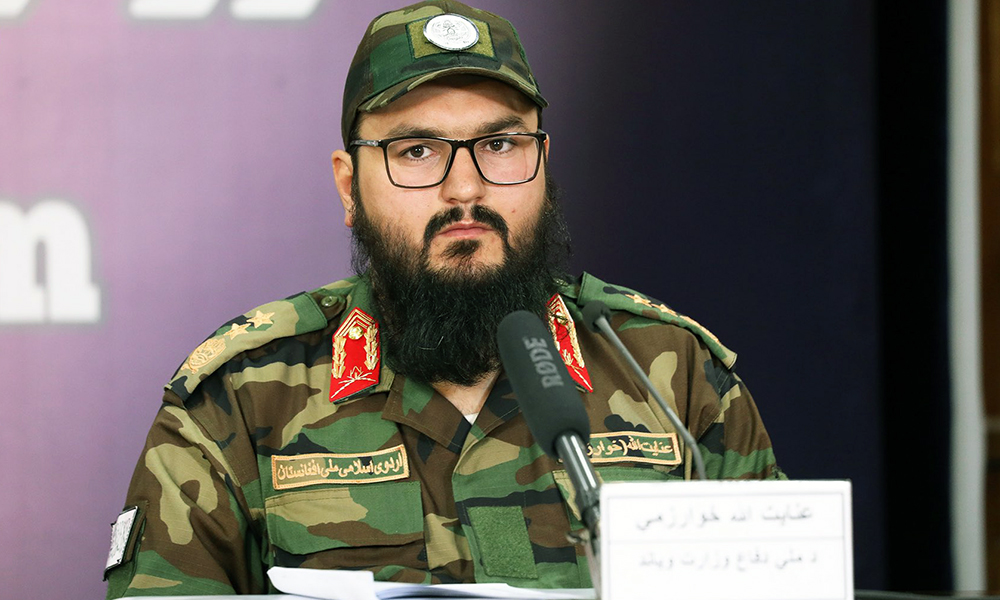Latest News
Enemies of Afghanistan and Islam cannot tolerate country’s freedom: Haqqani

Acting Minister of Interior Affairs Sirajuddin Haqqani says the enemies of Islam and the country cannot tolerate Afghanistan’s freedom and are trying to launch a conspiracy against the Islamic system.
On a trip to Paktia, Haqqani with some members of the cabinet of the Islamic Emirate met with some residents of this province and asked them to be united in supporting the Islamic system.
“The enemies of our religion and country cannot take away our freedom and now they are plotting and warning the system, but our belief is firm and our struggle is pure and we are united,” said Haqqani in an opening ceremony of a religious center.
Acting Minister of Information and Culture, Khairullah Khairkhah, also asked the people and youth of this province to make more and effective use of the opportunities created now in the country.
“This is the main way to success and you are lucky that there are scholars and you should make good use of the opportunities given by Allah,” said Khairkhah.
At this event, Acting Minister of Economy Din Mohammad Hanif also mentioned the sacrifices made to establish the Islamic system.
“It is known to all of us and to you that the majority of the sacrifices were made by the scholars, the Mujahideen, of course, all the people participated in this, but the leadership was led by the scholars,” said Hanif.
Meanwhile, Sirajuddin Haqqani has recently visited many provinces of the country and invited the people to be united in supporting the Islamic system.
Latest News
IED explosion in Badakhshan leaves 8 dead and wounded

Eight security force members were killed and wounded in an IED explosion in Badakhshan province on Wednesday morning, officials confirmed.
The Ministry of Interior said three policemen died and five others were wounded in the explosion.
Abdul Mateen Qani, the spokesman of the Ministry of Interior Affairs, said: “Unfortunately, at around 11:00 AM today, a sticky mine (magnetic IED) that was already embedded in a motorcycle exploded in the Jawozon area of Faizabad city, Badakhshan province.”
According to Qani the device detonated while a convoy of police was traveling through the area. Police had been carrying out a poppy clearing operation.
Police are investigating the incident, Qani said.
So far, no group or individual has claimed responsibility for the explosion.
Latest News
Khurasan beats Istaqlal 1-0 in ACL; Sorkh Poshan thrash Sarsabz Yashlar 4-1

Khurasan Faryab defeated Istiqlal Kabul 1-0 in the 35th match of Afghanistan Champions League (ACL) in Kabul on Tuesday, while Sorkh Poshan Khafi thrashed Sarsabz Yashlar 4-1 in the 36th match of the tournament on the same day.
Khurasan’s only goal against Istiqlal Kabul was scored by Farid Ahmad – who was declared man of the match.
In the second match of the day, Sorkh Poshan Khafi’s four goals were scored by Habibullah Hotak and Omid Rajabi.
Khurasan’s Habibullah Hotak received the man of the match award.
Wednesday’s matches will see Abu Muslim Farah FC take on Adalat Farah FC at 1 PM, while Maiwand FC will play Jawanan Wahedi FC at 3:30 PM.
The matches are broadcast live on Ariana Television.
Latest News
Pakistan is using its territory against Afghanistan: MoD

The Ministry of National Defense of Afghanistan (MoD) has strongly rejected Pakistan’s claim that the recent attack on Chinese nationals in Pakistan was planned from the territory of Afghanistan.
Late last month five Chinese nationals and one Pakistani were killed in a suicide bombing near Besham, in Pakistan’s Khyber Pakhtunkhwa.
A spokesman for the Ministry of Defense, Inayatullah Khwarazmi, said that Daesh came from Pakistan to the territory of Afghanistan and its goals were organized from there.
He said that Pakistan should respond to these actions.
Khwarazmi, said that in an area of Khyber Pakhtunkhwa, which is under the security of the Pakistan Army, the killing of Chinese nationals is either the weakness of the security institutions or their cooperation with the attackers.
Khwarazmi says that the Islamic Emirate has assured China that Afghans are not involved in such incidents.
The territorial tensions between Pakistan and Afghanistan are on the rise again. In the latest issue, Islamabad has accused Kabul of harboring terrorist networks.
Pakistan’s intelligence service has claimed that the Besham attack was planned in Afghanistan.
-

 Science & Technology5 days ago
Science & Technology5 days agoChina launches historic mission to retrieve samples from far side of the moon
-

 Latest News4 days ago
Latest News4 days agoTrans-Afghan railway project expected to be completed by end of 2027: Uzbek official
-

 Sport5 days ago
Sport5 days agoAino Mina and Khorasan secure 2-1 wins in Friday’s ACL matches
-

 Sport3 days ago
Sport3 days agoDu Plessis, Kohli help Bengaluru stay in IPL play-off race
-

 World4 days ago
World4 days agoHamas, CIA director to hold talks in Cairo on Gaza truce
-

 Latest News5 days ago
Latest News5 days agoAWCC launches telecom services in Kunar’s Noor Gul district
-

 Latest News5 days ago
Latest News5 days agoAfghan journalists ‘must be celebrated, supported and protected’: UNAMA
-

 Latest News3 days ago
Latest News3 days agoBan on opium cultivation in Afghanistan cost farmers $1.3 billion

























